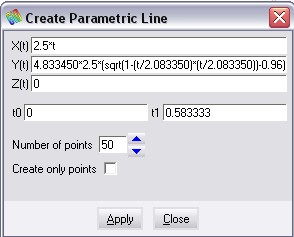
The NASA Almond is a classical target for Radar Cross Section (RCS) benchmarks.
Let's consider a bistatic RCS computation. The incident plane wave is parallel to the axis of the target. As a consequence, two symmetry planes can be considered. Only one quarter of the geometry will be simulated.
The geometry is generated using two parametric lines :



Collapse the model (to remove the middle point).
Use the rotation tool to create the surface (rotation of 90° around the Ox axis) :
Flat the surface along th Oz axis with a scale factor 1/3 to obtain the almond :

Assign the interface properties on the surfaces.
Set the symmetry planes :


Set an RCS computation :

Check the settings :

Set the frequency : 2 GHz
Save, generate the mesh and run.
The computed radar cross section :

Note : in this case, only the V polarization is valid. This is the polarization in the E symmetry plane. The H polarization is computed but must be discard. To obtain the H polarization, switch the E and H symmetry planes. The alternative way to get V and H in the same run is to simulate the entire geometry, but it will take much more computation time.
Copyright © 2015, IEEA